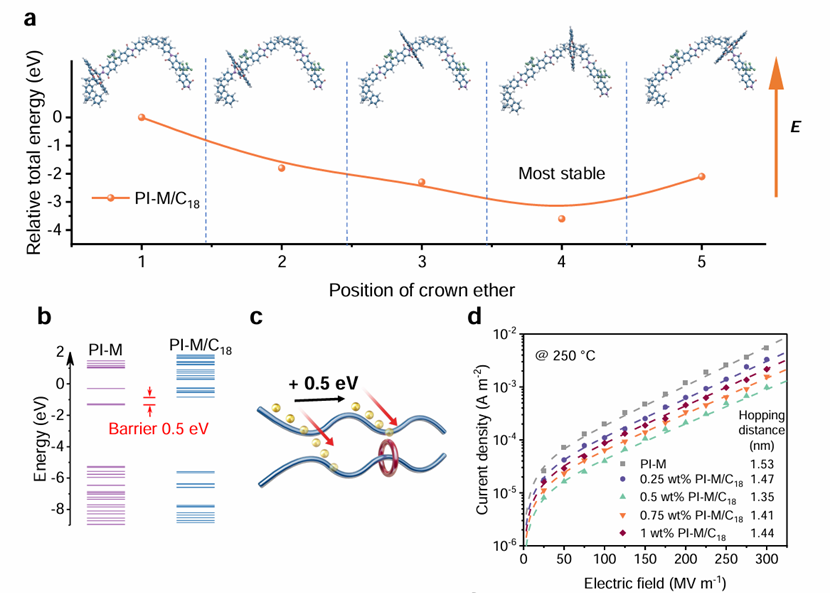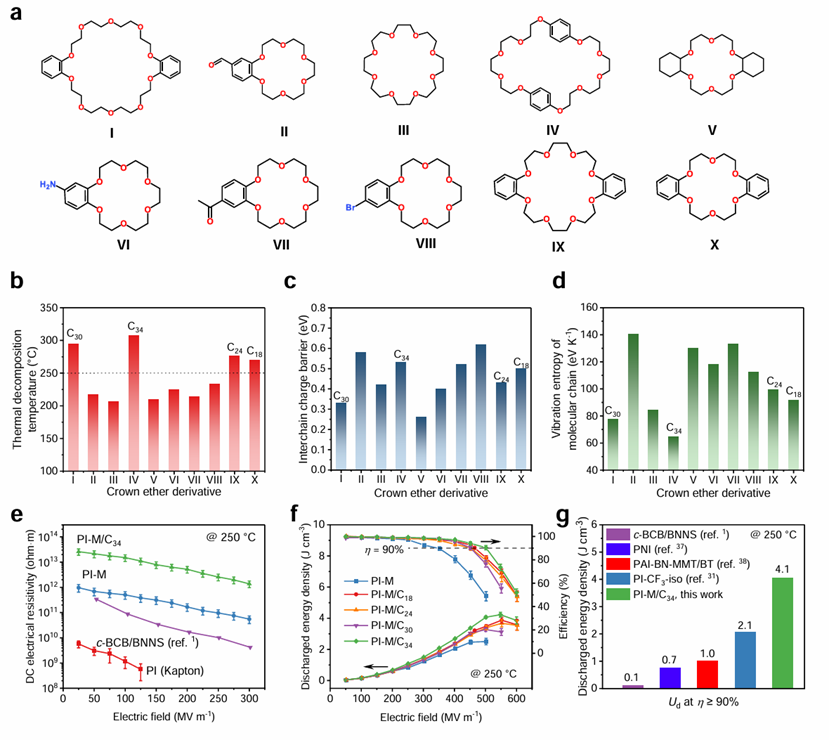Dielectric polymers are essential foundational materials in key technology areas such as electrical insulation and power-type energy storage. As the power of electrical devices and electronic components continues to increase, and as application scenarios expand, dielectric polymers face increasingly stringent operational requirements, including high temperatures and high electric fields. Although using wide bandgap, high-heat-resistant dielectric polymers can enhance temperature performance, their resistivity and dielectric energy storage performance significantly decrease when the temperature exceeds 200°C and a strong electric field is applied. Current theories and suppression methods for charge conduction in dielectric polymers cannot resolve the contradiction between material temperature resistance and insulation performance.
Recently, Professor Li Qi's research group from the Department of Electrical Engineering and Applied Electronics (EEA), Tsinghua University published a paper titled “Dielectric Polymers with Mechanical Bonds for High-Temperature Capacitive Energy Storage” in Nature Materials. The study revealed the charge conduction mechanism of dielectric polymers under extreme high temperatures and electric fields. The team used supramolecular chemistry to design a new class of polyrotaxane-based dielectric polymers with a "molecular damper" effect, achieving high insulation and efficient dielectric energy storage under extreme conditions.
Through fluorescence emission spectrum studies of various heat-resistant dielectric polymers, the research group found that when the temperature exceeded 200°C, the charge conduction along the polymer chains changed little, but charge conduction between chains (inter-chain) significantly increased. The charge transfer mechanism was primarily dominated by tunneling rather than the typical band transport. Based on this observation, the group proposed that charge conduction in dielectric polymers under such conditions is mainly due to phonon-assisted inter-chain charge tunneling. In disordered, intrinsically low-conductivity systems, phonons do not hinder charge transport but enhance electrical conductivity (electron-phonon coupling). Phonon-assisted charge transfer is unaffected by bandgap width and is strongly dependent on temperature-related local chain vibrations. This physical mechanism had been overlooked in previous high-temperature dielectric polymer studies, and it explains why earlier-developed high-heat-resistant, wide bandgap dielectric polymers do not exhibit high insulation under extreme conditions.

Charge Transfer Mechanism and Supramolecular Chemical Topology Design
Further, the team used supramolecular chemistry to insert crown ether ring molecules onto linear polyimide polymer chains, forming dielectric polymers with polyrotaxane structures. First-principles calculations and molecular dynamics simulations showed that the mechanical bonds formed between the crown ether molecules and polyimide chains could convert vibrational energy into elastic potential energy, thus suppressing the local vibrations of polymer chains and phonon-assisted inter-chain charge transfer at high temperatures. This "molecular damper" enables these polyrotaxane-structured dielectric polymers to overcome the main conduction mechanisms under extreme high temperatures and electric fields.

Molecular Dynamics Calculations of Chain Vibration and Fluorescence Spectroscopy Testing
Molecular dynamics simulations and experimental results revealed that crown ether molecules tend to move to the bending points (charge transfer weak points) of the polymer chains, forming inter-chain potential barriers and further limiting charge transport. The team screened ten crown ether molecules based on their high temperature tolerance, high inter-chain charge potential barriers, and low molecular chain vibration entropy, selecting the optimal crown ether structure. The best polymer topology exhibited an insulating resistivity four orders of magnitude higher than commercial heat-resistant dielectric polymers at 250°C, with a discharge energy density of up to 4.1 J/cm³ and charge-discharge efficiency exceeding 90%. The application of such materials will help break through the temperature and power limits of traditional electrical devices and electronic components, significantly reducing thermal management costs.

Charge Transfer Behavior and Charge Conduction Mechanism

Screening of Crown Ether Molecular Structure and High-Temperature Dielectric Energy Storage Performance
Associate Professor Li Qi of EEA is the corresponding author of the paper, with Postdoctoral Researcher Wang Rui as the first author and Ph.D. student Zhu Yujie as the co-first author. This research was supported by the National Natural Science Foundation of China.

















 News & Events
News & Events